|
In a
perfect world, refrigeration systems would be 100% efficient. Since refrigeration is basically a system of heat exchange,
heat exchange is an extremely important part of the equipment's efficiency. In
other words, in a perfect world, all of the heat would be transferred
without any losses at all. The cold liquid refrigerant in the
evaporator would absorb heat directly across any barriers. At the
same time, all this absorbed heat carried by the refrigerant through
outdoor coil would be transferred to outside air.
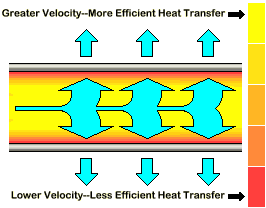
Since
we do not live in a perfect world, we will look at factors involved
in losing efficiency when cooling. The
first factor influencing efficiency is the flow of refrigerant
through the piping. When liquids or gases flow in pipes, they
produce a condition called Boundary
Layer Effect.
Boundary
layers appear on the surface of bodies in viscous flow in the cooling
coils because the fluid seems to "stick" to the surface.
Right at the surface the flow has zero relative speed and this fluid
transfers lack of momentum to adjacent layers through the
action of viscosity. Thus a thin layer of fluid with lower velocity than the outer flow develops. The requirement that the
flow at the surface has no relative motion is the "no slip condition."
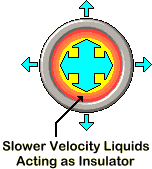
The zero slip
condition at the surface arises from the roughness of the surface on a molecular scale. Fluid molecules hitting the surface
impart a net momentum to the surface and the mean velocity of molecules hitting the surface is about the same as the surface
velocity.
Even when the surface is extremely smooth, electrostatic forces exist between the surface
and the air molecules, introducing the shear stress at the surface. This results in the liquids or
gases closes to the boundary being either warmer or cooler than in the center of the piping.
This "boundary layer serves as a sort of "insulator" to the liquids or gases closest to the center of the pipe
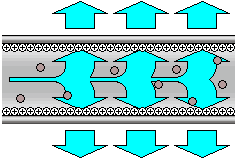
Adding a genuine Polarized Refrigerant Oil Additive to your system will increase
efficiency to a point even better than "new". The polarized molecules of
the additive have a positive "charge". This causes them to be attracted, magnetically, to the metal parts within your
system, most conspicuously seen in your piping and heat exchangers. The polarized particle serves two purposes: - By reducing friction losses in the piping.
- It
helps transfer heat because it has an extremely high heat-exchange co efficiency. This makes your system more efficient,
producing colder temperatures...reducing the amount of time your system needs to "work".
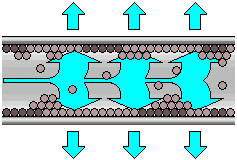
|
| Oil Carryover |
| Another factor affecting efficiency is "oil carryover". Oil carryover is not a desirable
condition, but it is practically unavoidable. Your compressor requires oil to accomplish two tasks. First, the
oil provides lubrication to moving parts within your compressor system. Second, it serves as a seal, necessary in a
closed system like air conditioning and refrigeration. Even screw
compressors, which are the best performers in terms of oil carryover will produce this phenomena.
This carryover results in oil being deposited onto the walls of your piping, where it acts as an insulator. This reduces
the heat exchanging properties of your system. |
|
A properly formulated Polarized Refrigerant Oil Additive does not treat the oil, it treats the METAL. First, it displaces
the oil adhering to the walls of your piping. Then, it remains in place providing a barrier which stops oil from adhering
after treatment. |
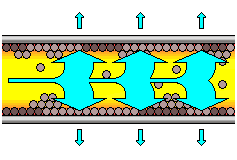
|
| Resulting Combination |
As you can see, the combination of the two conditions (boundary layer effect and oil carryover) constitute a "one-two
punch" which adversely affects your refrigeration efficiency. A properly
formulated Polarized Refrigerant Oil Additive does not treat the oil, it treats the METAL. First, it displaces the oil
adhering to the walls of your piping. Then, it remains in place providing a barrier which stops oil from adhering after
treatment. Polarized Refrigerant Oil Additives will even displaced "cooked" (or carbonized) deposits, allowing them to be flushed or cleaned out and
will be caught up in the system's dryer. This is one of the reasons it is so important to perform follow-up checks after
installation.
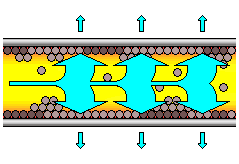
|
| Resulting Combination |
|

